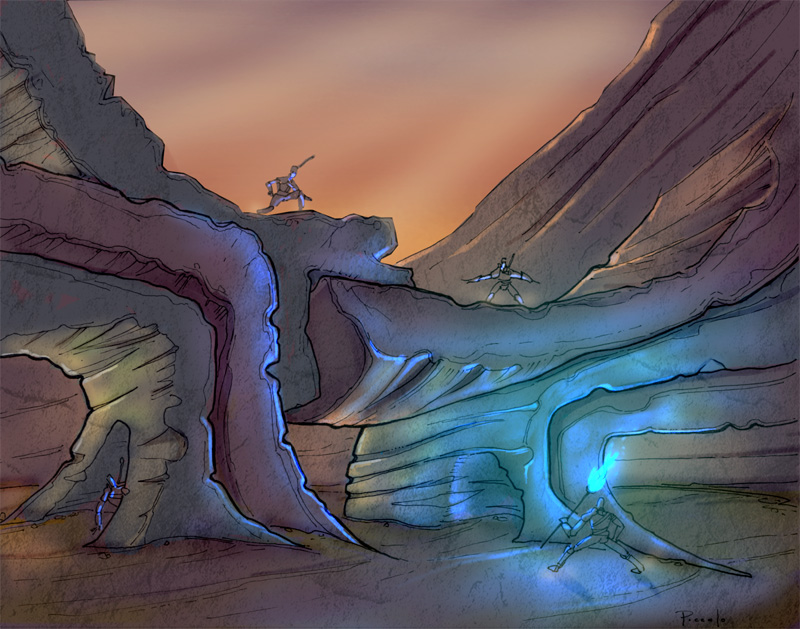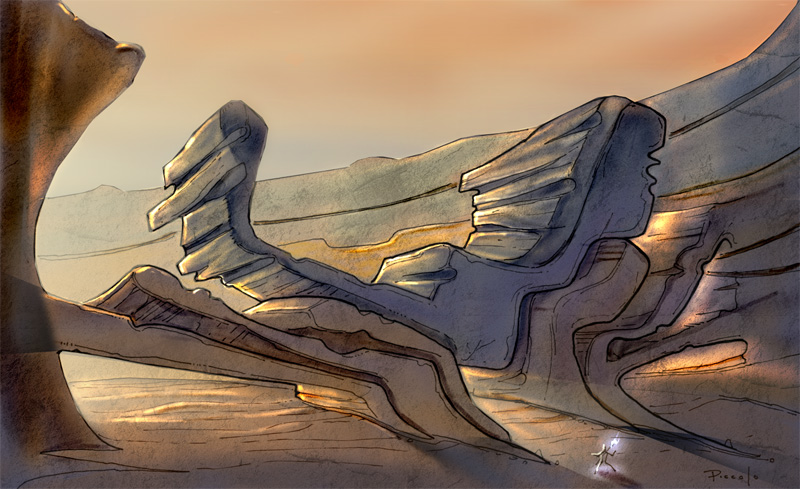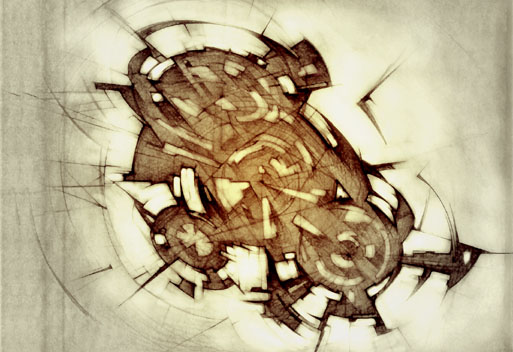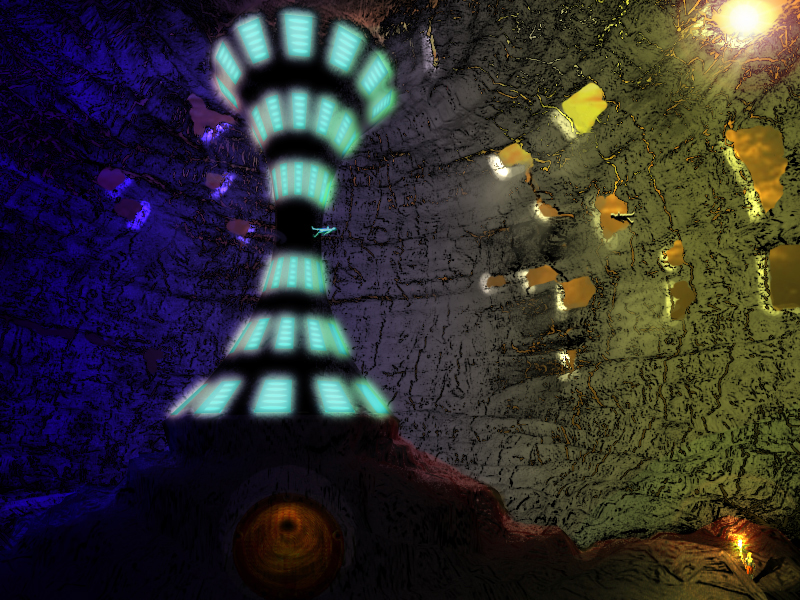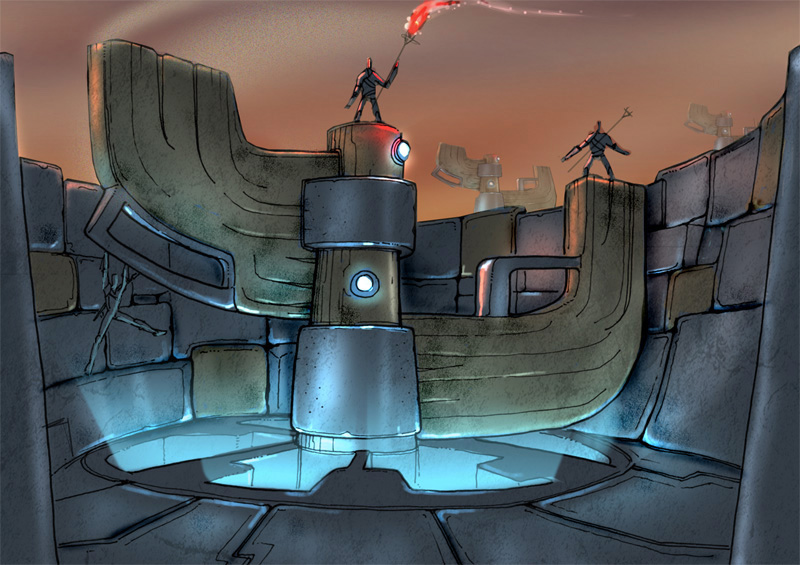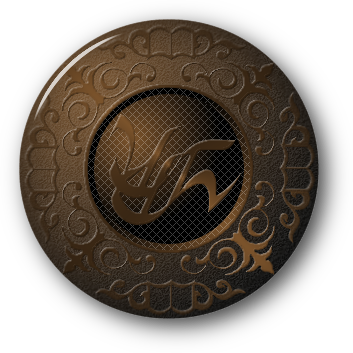

|
|
The DRC appears to have discovered a linking book to the Age of Pento sometime in AD 2000. They conducted an initial survey of the Age and found the landscape to be bleak and barren. In September of the year 2000, the DRC suspended retoration of the Age in phase one by recommendation of Dr. Ikuro Kodama. His note simply read, "Pento - 9/2000 - Unstable resources - K." Unstable resources probably meant that they didn't have the money, manpower and time to continue exploring it after a brief survey. When the DRC returned to the cavern for a second restoration attempt with new funding, they held another vote on restoring Pento on September 30th of 2006. Again, the suspension was unanimously sustained with a note that they would re-assess the Age at later date. That day never came because the financial backing of the second restoration was withdrawn and the DRC was disbanded again. The Age:The Age of Pento consists of a windy plain with steep-sided, chasm-like canyons carved into it. There are natural stone arches bridging it in places. The surface of the plain is harsh and bleak with little to sustain life. The people of the Age lived in the canyons where they had shelter from the constant wind, but even there the conditions were difficult and grew worse year by year.
The Age is centered around a half-square-mile playing field used for a ritual sport that involved navigating an obstacle course that was partly on the surface and partly underground. The object of the game was to carry fire from three different start points to a finish point without the flames being blown out by the strong winds in the Age. It was cooperative and two runners would pass the flame back and forth between their torches to keep it burning. That was necessary because the torches would burn out before the course could be covered, and there were places where a contestant couldn't carry a lit torch. The playing field was made up of a maze of trenches, buttes, pillars, steppes, and caves. The following picture shows an overview of the outside field. The circular area in the lower right is the site of the arena that made up part of the field.
This picture shows a ground level view of part of the playing field, with a figure standing in the entrance to one of the caves. This is the exterior of the arena. The DRC thought it looked like a gigantic apple.
The following picture shows the interior of the arena.
This picture is part of the obstacle course torch runners had to overcome.
More of the course.
This picture shows some of the terrain in the inhabitable .part of the Age.
A Pento Legend:According to the available documents, the people of Pento believed in two gods, the god of Wind and the god of Fire. In the beginning, the two were good friends and worked together to create the world. When the time came to populate the world, Fire belched out burning embers and Wind cooled them off and brought them to the ground where they transformed into people. But the gods' friendship was sorely tested after the creation of humanity. One day a woman was born to the people whose beauty was immediately noticed by both the god of Wind and the god of Fire. Both wanted her for their own. For twenty years Fire and Wind fought for the woman’s attention, and as a result destroyed most of Pento with wind storms and blazing heat and fire. As they contended, a young warrior of the people also decided that he wanted the woman for his own, and he claimed that neither Wind nor Fire had a right to her. As a result, war broke out between the Fire, Wind, and the young man over the woman. The young man took the woman and tried to bring her to a place where neither Fire nor Wind could take her from him. To get there, they had to cross the high plateau of their world where both the Wind and Fire could easily see them. It did not take longer than one day atop the plateau for the warrior to realize that they would never make it across. Fire tried to kill him by spewing down balls of molten rock from the sky, and Wind hurled strong gusts at him, trying to knock him off the precipices that surrounded them. The young man decided that he and the woman would have to navigate through underground passages in order to escape. However, once in the caves, the lack of Fire meant there was no light, and the pitch-black darkness made it impossible to see where they were going. The young man left the woman in the caves for safety, and gathered a stick and rags to make a torch. Then he climbed back up to the plateau where he managed to capture some of the fire still burning from the balls of rock that Fire had hurled at him earlier. The light from the torch provided light to navigate through the caves, and they were no long within the reach of Fire. But the trials were not over. Wind could still reach him in the caves and attacked him relentlessly, constantly trying to extinguish the fire of his torch. To aid against losing their only source of light, the warrior returned to the plateau and made another torch for the woman. The pair then traveled through the caves, passing their torches back and forth when one was blown out or one of them needed both hands to climb. By cooperating, the young man and woman were able to find their way safely through the caves and away from where Fire and Wind could harm them. Once they were in a place where they could rest, the woman told the warrior that there was an even safer place that they could go. While wooing her, Fire and Wind had told her some of their secrets. One of those secrets was that gathering the three sacred fires together that were burning on the plateau would allow them to escape to another world where neither Wind nor Fire lived. It took much effort and no little risk, but working together the warrior and the woman were able to collect the three fires on their torches and bring them to the designated place on the plateau. However, the work had been for nothing. Even when the fires were burning together, no doorway to another world opened. But they still had a happy ending to their story. Greatly impressed by his courage and resourcefulness, Fire and Wind both acknowledged that man had earned the right to take the woman as his wife. They also realized that while chasing the young man, they had become friends again and that they had thoroughly enjoyed the contest. So Fire and Wind made a pact with the man and woman that day. If they would convince their people to make the contest a regular event and race through the caverns trying to collect the fires and running from the wind, the gods would allow that young man and woman to become gods and rule over the world beside them. And so it was that from that day forward, the people of Pento cherished the tradition of racing through the windy caves, carrying torches to the goal to please the gods who now included two of their own kind. Pento and D'ni:The meeting of D'ni and Pento wasn't a tale of peace and cooperation. Far from it. It was a tale of war and cruelty. The consequences of the meeting affected D'ni society for millennia and ended the Pento people. It had great influence on D'ni art and medicine, and affected their relations with arotantē peoples in other Ages. And as many another story of war and violence, it began with religious differences. It was during the reign of King Korēn that the story of Pento and D'ni began. A religious cult who called themselves the Judges of Yavo believed that they were called to exercise judgment over the rest of D'ni, because they believed that only they truly knew the will of Yavo. They existed in obscurity for a long time, but that was to change. In the late part of the 13th D'ni century a leader named Āris was raised among them, and he had a craving for power over his fellow D'ni. In the year 1303 he was able to gather the resources to attain it. In that year, a Writer guildsman vanished under mysterious conditions. A few days later, a number of blank Books and bottles of Ink disappeared from the stocks of the Guilds of Books and Ink Makers. Korēn issued orders for increased security among the Guilds and launched a massive search for the missing Writer and the books and ink, but none of them were found. It would later be revealed that the writer was a member of the Judges and they had hidden him. The Judges stole the writing materials and had their man lead a project to create illegal Ages. They were deliberately breaking D'ni law by writing Ages with native peoples in an attempt to find some that they could control and force to go to war for them. Seventeen years later, in DE 1320, the Judges wrote an Age called Pento that had the people they needed. The people of the Age were a warrior culture living in a world that was becoming less and less able to support them. The Pento were too fierce for the Judges to coerce into fighting for them, but they had something the Pento wanted desperately — the ability to write a new Age where the Pento could live and prosper. With a promise of creating a new home for the Pento that had plentiful resources, the Judges had the army they'd been searching for. Better yet, it was an army that would willingly go to war on their behalf. In DE 1323 the Judges and their Pento allies were ready. Korēn's wife had gone into labor and was about to give birth to his first son. While it's not stated in Korēn's notebook, it was entirely possible that people would have gathered into a large crowd waiting outside the palace for news of a successful delivery. In that kind of hustle and bustle and with everyone distracted, it would have been relatively simple for a party of Judges and their Pento allies to infiltrate the Island and launch an assault on the palace. That is precisely what they did. When informed about the invasion, Korēn gave orders to the palace guards to evacuate his family while other guards fought to hold off the surprise attack. Korēn and his family were rushed down to the harbor, where a boat to the D'ni city was waiting for them. Their goal was a linking book to a private Age that the king had there. The small boat was able to fit into the narrow gap in the King's Arch and they sailed directly to it. Going through the Arch was a more direct route than using the main harbor entrance tunnel and going around the side of the Island. While traveling through the King's Arch, it's said that Korēn's wife delivered his son, Alsendar. After seeing his family link through the private book to safety, Korēn remained behind to command the combined forces of the D'ni city guard, the small standing army and the maintainers. Pento warriors proved to be a formidable opponent, and the city grew more and more dangerous to be in as the days passed. The Judges had a policy of destroying buildings that housed loyalists and murdering ordinary citizens whenever they caught them. In response, Korēn poured money into equipping the City Guard and the regular army. However, it seemed to be too little, too late and they were unable to gain the upper hand. He commanded the D'ni soldiers resisting the invasion for twenty-nine years. In DE 1352 Korēn's luck ran out and he was caught and assassinated by a group of Pento warriors being led by Judges. His death threw the city into chaos and to the Judges it seemed like it was only a matter of time until their victory would be complete. Having been born the year of the invasion, Alsendar was twenty-nine years old and living with his mother in their refuge Age when his uncle arrived to tell him that his father had been killed. He didn't rush to the city upon hearing the news. His uncle apparently advised him to hold off and devise a plan instead. Along with a few advisers who were keeping him updated on the progress of the war, Alsendar did as his uncle had suggested and formulated a strategy to turn the war in D'ni's favor. His uncle, who was a member of the Guild of Linguists, had been translating the Pento language and learning as much as he could about them. In the meanwhile, the Judges proclaimed victory and assumed control of the D'ni government, although the fighting wasn't over by any means. Even as D'ni military forces continued to harass them in the caverns, the Judges began leading their Pento allies into some of the most important Ages of the D'ni empire. Alsendar still continued to receive intelligence briefings from his uncle and waited for the right time to make a move. A few weeks later, Alsendar's patience paid off. A report arrived that the Judges had killed the leader of the Pento. It said that the Judges were afraid that he had grown too powerful and that they were losing control of him. That had an unexpected consequence. The leader had two sons named Mekarr and Timaue, and had not declared which one was to be his heir. His death caused the sons to fight over the succession, and a civil war broke out between their factions. Because of the conflict, the Pento concentrated on their own affairs and ignored all of the orders sent to them by the Judges. The Judges were suddenly left with only their own membership as a military force, and those members were spread out in the Ages they had invaded. The D'ni city suddenly had much fewer soldiers who were loyal to the Judges. The D'ni public apparently knew Alsendar was biding his time. They remembered the prophecy of Ūrpa, and it seemed to them that they were witnessing its words coming to life. "Only the stone, while they pass beneath, listens to his cries and comforts her fear. Only the Arch welcomes the reign of the great one who guides us." They all knew that Alsendar had been born directly under the King's Arch, which was a replica of a monument on Garternay built just in case the prophecy was meant for D'ni. They believed that the next line, "A new people, people of light, will bring great havoc to the dark," was a foretelling of the Pento invasion, and that the line, "He remains hidden, while another sits in his throne," was an obvious reference to Alsendar and the leader of the Judges. As the people awaited the time when Alsendar made his move, the anticipation caused them to grow even more willing to fight for him when he did. The time came fifteen weeks after the death of King Korēn. Alsendar, leading the small detachment of soldiers who had guarded him and his mother in the refuge, linked back to the D'ni city. For the first time in his life, Alsendar saw with his own eyes the places he'd read reports about and whose maps he'd studied with his advisors. Marching down to the docks, he and a small detachment of his soldiers boarded a boat similar to the one he and his mother had fled in. They sailed to the Island directly through the King's Arch on their way to retake the palace. With so few of the Judges available to defend it, the task of clearing the palace was relatively easy. Meanwhile, several of his soldiers who had split off from the Alsendar's detachment were following the orders they'd been given. Some traveled throughout the caverns to gather the loyalist groups who were still fighting the Judges, and others to establish safe zones for refugees. As the soldiers carried out their assignments, they were joined by D'ni citizens who had witnessed or heard about Alsendar's arrival. While most weren't trained soldiers, they greatly increased the number of able bodies available for him to command. After Alsendar established his base of operations in the palace, he set about reorganizing the D'ni military forces. Once lines of communication had been re-established, he enacted the next step in the plan he'd worked out with his uncle and his advisors. A messenger was dispatched to contact the Pento faction that supported Mekarr, with a letter saying that Alsendar wished to negotiate a deal with him. Alsendar's proposal was that he would help Mekarr defeat his brother if, in return, the Pento would abandon the Judges and retreat to their homes peacefully. Mekarr agreed on the condition that Alsendar would have a new home Age written for them as the Judges had promised but not delivered. After the details were agreed to, a treaty was signed between them. In DE 1376, Alsendar led a D'ni military expedition to the Pento Age. D'ni history called the invasion the Battle of the Great King, and it was a total victory for the alliance of Mekarr and Alsendar. Mekarr turned over two of the leaders of the Judges to Alsendar, and three more were found in the D'ni city later. All five were sent to Prison Ages and the books were burned. A number of influential D'ni had demanded that they be put to death, but Alsendar refused for unstated reasons. A few weeks later, Alsendar was crowned, and it was said that "not one on D'ni did not attend the event. Our cheering was as loud as thunder and our pride as solid as the Arch through which he sailed." That should have been the end of the story, but it wasn't over yet. Alsendar didn't trust the Pento in general and Mekarr in particular, so he secretly worked with the Guilds of Writers and Healers on a biological weapon custom tailored for them just in case it might be needed in the future. The linking books between D'ni and the new Pento Age were left in place because Alsendar insisted on continued contact with them. His advisors argued that the books should be destroyed, but he didn't listen. In D'ni year 1466, Alsendar's distrust and desire to keep a way to get at the Pento proved to be justified. For reasons that are not mentioned in the records, Mekarr came to the Palace via secret linking books that the Judges had given to him and his brother. He'd kept them hidden from D'ni. It's not known why, but he personally assassinated Alsendar's wife along with the two sons they'd had together. Alsendar was furious and chased Mekarr personally. When he caught up to the man, he killed him in what records simply say was "an astounding battle." Two days later, and once again against the advice of his courtiers, Alsendar ordered the release of the biological weapon into the new Pento Age. It struck quickly and spread rapidly into a plague. The records do not say how the plague was released, but the result was as gratifying to the weapon's creators as it was horrible. The entire population of New Pento died within three days of it being set loose among them. That was not so quickly that it forestalled an unplanned tragedy. Most of the Pento realized that a sickness had been set upon them and linked to a number of other Ages in attempts to escape. That's when it took an unplanned turn; Alsendar had wanted it to only affect the Pento, but that may have been too much to ask. Instead, the healer guildsmen who engineered it made it to not harm D'ni people. The Pento who tried to escape the disease ended up infecting numerous other arotantē cultures before dying, and the loss of life wherever they went was horrifying. Since it was designed not to, the sickness did not infect those of D'ni heritage. However, when the Guild of Chemists learned about the disease, they began to fear that it might mutate into something that could. When the D'ni public heard about the plague that was spreading through the empire, they blamed the Pento for the devastation since they had no knowledge of their own government's creation of the disease. In response, all of the books to which the Pento had had access were gathered together with the intention that they would be burned and any surviving arotantē peoples in those Ages left on their own. The books were gathered, but they were stored away instead. Four years later, in D'ni year 1500, Alsendar called a gathering of his people to inform them of the truth. In the speech he gave, he admitted that he had created the plague and ordered its release. At the end of the speech, he asked to be sealed into the Temple of the Great King along with all of the books to infected Ages and with any books that linked the D'ni to their past on Garternay. A year later, as he requested, Alsendar was sealed into the Temple with a large but unknown number of books. One of those books was probably their linking book to Terahnee, the Age to which most of the Ronay had moved. The story of D'ni and the Pento Plague simmered for a time during the reign of Solath, Alsendar's successor, but it was far from over. In D'ni year 2015, a man named Gan took the throne in at the age of one hundred and forty-four. He never got a chance to do much to distinguish his reign, thanks to his grandmother, a woman named Jolatha. Six months after Gan's coronation, D'ni people began falling sick. The sickness developed into an epidemic, and soon was declared a plague. In their attempts to identify and treat the illness, the Guild of Healers discovered that it was a variant of the Pento Plague, which had mutated just as the Guild of Chemists had been afraid would happen. The evolved version caused a swift death by heart failure in the very young and the very old, and adults had their life expectancies cut by half. Even worse, it caused massive infertility and the birth rate among the D'ni dropped drastically from its already low frequency. Once word spread that the plague was similar to what the Great King had created, the D'ni people put most of the blame for the illness on Alsendar. What few knew was that Jolatha, Gan's grandmother, had ordered that the tomb where Alsendar had been sealed be reopened because she wanted the books he'd taken with him to give to a religious cult she favored. Those who knew about the breaking of the seal evidently kept their mouths shut. Despite the low fertility rates, Gan managed to have a son named Benashiren in 2050. When Gan died and left his son the throne, it was to rule over a population that was slowly dying both physically and emotionally. Benashiren took the throne in 2070 at the age of twenty, making him the youngest D'ni king ever. Even by surface standards, he was young, untrained, and too inexperienced to become a good king. He showed his immaturity many times during his rather short reign. He was easily swayed in his religious views, sometimes begging Yavo for healing and other times calling upon The Tree, a central figure in Jolatha's favored cult. Instead of supporting the Guilds of Healers and Chemists, who were desperately searching for a cure, he publicly denounced them with accusations of shallow efforts and failing their own people. As the adult population continued to die, the number of children born decreased tremendously. Benashiren died in D'ni year 2193 at the age of 143 without siring any heirs. There were so few children being born by then that Benashiren couldn't find a suitable person to leave the throne to even among his court. The only choice left for him was to appoint his 179 year old uncle as the crown prince. It was later deemed a miracle that he'd made that choice because, some dared to say, Benashiren was "far too ignorant to choose an heir that made so much sense" on his own. And so Benashiren's uncle Hemelin took the throne in 2193 at the age of 179. Hemelin had been a master in the Guild of Healers before his coronation, and it was later claimed that he took the throne "with rage in his heart and fire in his mouth." Disgusted and furious about the way Benashiren had aroused negative public opinions against his Guild, he made it his mission to find a cure for the plague. It was the opinion of historians that he exercised more power and authority in the first week of his rule than his nephew had in his entire life. Hemelin was convinced that a cure must lay in a body of records called the Books of Old. D'ni healers had been able to craft the original plague, so he believed that they must have gotten the knowledge to do it from somewhere, or at least recorded what they had done. So he began pressing for permission for the Healers Guild to look through the books long before his coronation. That effort was hindered by Benashiren, who was inexplicably hesitant to allow the healers to read them. When Hemelin became king, he immediately gave the Healers full access to all the research material available. Things came to a head when Hemelin contracted the plague and became extremely ill in D'ni year 2255. Most of his advisors and healers thought he was going to die despite everything they tried to prevent it. Then a miracle appeared in the form of a young nurse who had been sent to take care of him in his last days. Her name was Lalen, and as time passed, Hemelin found himself, in his own words, "living just to see her one more time." Lalen, as it turned out, must have felt the same way, and their newfound love forged a will to live in Hemelin that the disease could not extinguish. He was able to recover his health and right up to the day he died, he praised Lalen as the reason he survived when so many others had died. If that wasn't enough, there was another excellent reason why Lalen became one of the most revered women in D'ni history. Two years after Hemelin recovered, she was searching through the Books of Old and found hints about where more of them had been taken for storage. A few months later, she was instrumental in tracking down a tome called the Book of Birenni, a Healer's guild treatise that Hemelin had always wanted to find but could not. Once the book was in the hands of the Guild, it was just six years later in D'ni year 2262 that a team of healers led by Guild Master Jāsem announced that the Pento plague was finally cured. The announcement sparked tremendous celebrations, the like of which had never been seen before in the caverns. That day was also notable because it was the day that Hemelin and Lalen were married in a grand ceremony. The story of the romance of Hemelin and Lalen was already a hit with the D'ni people, and it became a classic theme in their art, music and plays. The date of their wedding went on to become the most favored day for young D'ni brides to have their own marriage ceremonies in the hope that their lives would be filled with a similar love. That was the end of the Pento Plague in the D'ni empire. But yet again, it wasn't the end of the story. Hemelin's successor, Nāgen, took the throne in 2356 DE at the age of eighty-six. In D'ni year 2397, the Eamis Theatre Company hosted the first play written by a playwright named Sirreh. The play dealt with the Pento War and the Great King Alsendar. In addition to earning praise from King Nāgen, it ended up being sold out for three straight weeks and marked not only the start of theater as a popular form of entertainment among the D'ni, it was also the first use of the Pento War as a subject. The history of the war would go on to become one of the most frequent themes in D'ni art. In 2408, a thirty-three year old musician named Ārem began selling out concert halls, and would become one of the most notable musicians in D'ni history. His music was often about the Great King, and both praised and satirized him, sometimes to the point of outright ridicule. Nāgen enjoyed his work as well, saying that it was wonderful that people were able to express "their true feelings in such wonderful displays of art." The final part of the story of D'ni and the Pento Plague was to come long after the D'ni empire died. In what was the early 19th Century on the surface, Ātrus, his Averonese assistants, and D'ni who had survived the Fall of the empire and whom Ātrus had found and reunited discovered the linking book to Terahnee that had been sealed in the Tomb of the Great King. Linking through it, they discovered the descendants of the Ronay who had moved there. They were dismayed to learn that the Ronay had become the master class over an empire of slaves. While it's not said exactly what the illness was, the D'ni were carriers of intestinal microbes that spread to the Ronay of Terahnee and killed nearly ninety-nine percent of them in a matter of weeks. The D'ni were immune to the microbes, but their Terahnese cousins were not, having never been exposed to anything like it. Given how suddenly and thoroughly the disease struck and killed the Terahnese, I strongly suspect that it was the last strike of the Pento Plague, and showed that the disease created to destroy New Pento still had the ability to enact genocide on a grand scale thousands of years after it had first been created. So, It is with the death of the slave masters of Terahnee that the story of D'ni and Pento finally comes to a conclusion. But perhaps the ending of this tale, too, has not yet been written. |
Myst, the Myst logo, and all games and books in the Myst series are registered trademarks and copyrights of Cyan Worlds, Inc. Myst Online: Uru Live is the sole property of Cyan Worlds Inc. The concepts, settings, characters, art, and situations of the Myst series of games and books are copyright Cyan Worlds, Inc. with all rights reserved. I make no claims to any such rights or to the intellectual properties of Cyan Worlds; nor do I intend to profit financially from their work. This web site is a fan work, and is meant solely for the amusement of myself and other fans of the Myst series of games and books. |
